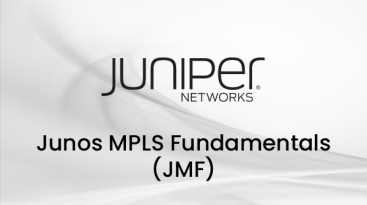Genel Bakış
This course is designed to provide students with a solid foundation on Multiprotocol Label Switching (MPLS). After introducing concepts such as MPLS forwarding and the structure of the MPLS header, the course will delve into the configuration and operation of the two main label distribution protocols, RSVP and LDP. Special emphasis is given to the central topics of traffic engineering and MPLS traffic protection, including fast reroute, link/node protection, and LDP loop-free alternate.
Eğitim Süresi 2 gündür.
Eğitim takvimi sayfamızda güncel eğitim tarihlerimizi bulabilirsiniz.
Eğitim Ön Koşulları
Students should have intermediate-level networking knowledge and should be familiar with the Junos OS command-line interface (CLI). Students should also attend the Introduction to the Junos Operating System (IJOS), Junos Intermediate Routing (JIR), and Junos Service Provider Switching (JSPX) courses prior to attending this class.
Eğitim İçeriği
Course Introduction
MPLS Fundamentals
- MPLS Foundation
- Terminology
- MPLS Configuration
- MPLS Packet Forwarding
Label Distribution Protocols
- Label Distribution Protocols
- RSVP
- LDP
- Seamless MPLS
Routing Table Integration
- Mapping Next Hops to LSPs
- Route Resolution Example
- Route Resolution Summary
- IGP Passive Versus Next-Hop Self for BGP Destinations
Constrained Shortest Path First
- RSVP Behavior Without CSPF
- CSPF Algorithm
- CSPF Tie Breaking
- Administrative Groups
- Interarea Traffic Engineered LSPs
Traffic Protection and LSP Optimization
- Default Traffic Protection Behavior
- Primary and Secondary LSPs
- Fast Reroute
- RSVP Link Protection
- LDP LFA and Link Protection
- LSP Optimization
Fate Sharing
- Junos OS Fate Sharing
- SRLG
- Extended Admin Groups
Miscellaneous MPLS Features
- Forwarding Adjacencies
- Policy Control over LSP Selection
- LSP Metrics
- Automatic Bandwidth
- Container LSPs
- TTL Handling
- Explicit Null Configuration
- MPLS Pings
Eğitim Hedefleri
- Describe the history and rationale for MPLS, as well as its basic terminology.
- Explain the MPLS label operations (push, pop, swap) and the concept of labelswitched path (LSP).
- Describe the configuration and verification of MPLS forwarding.
- Describe the functionalities and operation of RSVP and LDP.
- Configure and verify RSVP-signaled and LDP-signaled LSPs.
- Select and configure the appropriate label distribution protocol for a given set of requirements.
- Describe the default Junos OS MPLS traffic engineering behavior.
- Explain the Interior Gateway Protocol (IGP) extensions used to build the Traffic Engineering Database (TED).
- Describe the Constrained Shortest Path First (CSPF) algorithm, its uses, and its path selection process.
- Describe administrative groups and how they can be used to influence path selection.
- Describe the default traffic protection behavior of RSVP-signaled LSPs.
- Explain the use of primary and secondary LSPs.
- Describe the operation and configuration of fast reroute.
- Describe the operation and configuration of link and node protection.
- Describe the operation and configuration of LDP loop-free alternate.
- Describe the LSP optimization options.
- Explain LSP priority and preemption.
- Describe the behavior of fate sharing.
- Describe how SRLG changes the CSPF algorithm when computing the path of a secondary LSP.
- Explain how extended admin groups can be used to influence path selection.
- Explain the purpose of several miscellaneous MPLS features.
Eğitime Kimler Katılmalı?
This course benefits individuals responsible for configuring and monitoring devices running the Junos OS.
Genel Bakış
This course is designed to provide students with a solid foundation on Multiprotocol Label Switching (MPLS). After introducing concepts such as MPLS forwarding and the structure of the MPLS header, the course will delve into the configuration and operation of the two main label distribution protocols, RSVP and LDP. Special emphasis is given to the central topics of traffic engineering and MPLS traffic protection, including fast reroute, link/node protection, and LDP loop-free alternate.
Eğitim Süresi 2 gündür.
Eğitim takvimi sayfamızda güncel eğitim tarihlerimizi bulabilirsiniz.
Eğitim Ön Koşulları
Students should have intermediate-level networking knowledge and should be familiar with the Junos OS command-line interface (CLI). Students should also attend the Introduction to the Junos Operating System (IJOS), Junos Intermediate Routing (JIR), and Junos Service Provider Switching (JSPX) courses prior to attending this class.
Eğitim İçeriği
Course Introduction
MPLS Fundamentals
- MPLS Foundation
- Terminology
- MPLS Configuration
- MPLS Packet Forwarding
Label Distribution Protocols
- Label Distribution Protocols
- RSVP
- LDP
- Seamless MPLS
Routing Table Integration
- Mapping Next Hops to LSPs
- Route Resolution Example
- Route Resolution Summary
- IGP Passive Versus Next-Hop Self for BGP Destinations
Constrained Shortest Path First
- RSVP Behavior Without CSPF
- CSPF Algorithm
- CSPF Tie Breaking
- Administrative Groups
- Interarea Traffic Engineered LSPs
Traffic Protection and LSP Optimization
- Default Traffic Protection Behavior
- Primary and Secondary LSPs
- Fast Reroute
- RSVP Link Protection
- LDP LFA and Link Protection
- LSP Optimization
Fate Sharing
- Junos OS Fate Sharing
- SRLG
- Extended Admin Groups
Miscellaneous MPLS Features
- Forwarding Adjacencies
- Policy Control over LSP Selection
- LSP Metrics
- Automatic Bandwidth
- Container LSPs
- TTL Handling
- Explicit Null Configuration
- MPLS Pings
Eğitim Hedefleri
- Describe the history and rationale for MPLS, as well as its basic terminology.
- Explain the MPLS label operations (push, pop, swap) and the concept of labelswitched path (LSP).
- Describe the configuration and verification of MPLS forwarding.
- Describe the functionalities and operation of RSVP and LDP.
- Configure and verify RSVP-signaled and LDP-signaled LSPs.
- Select and configure the appropriate label distribution protocol for a given set of requirements.
- Describe the default Junos OS MPLS traffic engineering behavior.
- Explain the Interior Gateway Protocol (IGP) extensions used to build the Traffic Engineering Database (TED).
- Describe the Constrained Shortest Path First (CSPF) algorithm, its uses, and its path selection process.
- Describe administrative groups and how they can be used to influence path selection.
- Describe the default traffic protection behavior of RSVP-signaled LSPs.
- Explain the use of primary and secondary LSPs.
- Describe the operation and configuration of fast reroute.
- Describe the operation and configuration of link and node protection.
- Describe the operation and configuration of LDP loop-free alternate.
- Describe the LSP optimization options.
- Explain LSP priority and preemption.
- Describe the behavior of fate sharing.
- Describe how SRLG changes the CSPF algorithm when computing the path of a secondary LSP.
- Explain how extended admin groups can be used to influence path selection.
- Explain the purpose of several miscellaneous MPLS features.
Eğitime Kimler Katılmalı?
This course benefits individuals responsible for configuring and monitoring devices running the Junos OS.






